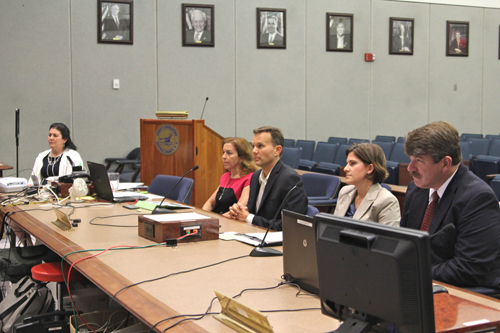County assembles panel to discuss die-off of fish and turtles

County lawmakers, scientists and environmentalists acknowledge nitrogen overloading in local waterways is the biggest contributor to the recent die-off of fish and turtles.
They also agree aging septic tanks and failing cesspool systems are mostly to blame for brown and red tides in the Peconic Estuary, as well as toxic blue-green algae at Lake Marratooka in Mattituck.
The public’s reliance of fertilizers is a problem, too, experts say.
In an effort to address the recent fish kill in Riverhead that some experts have described as unprecedented, Legislator Dr. William Spencer (D-Centerport), chairman of the Suffolk County Health Committee, assembled a panel discussion at Thursday’s health committee meeting in Hauppauge.
Panelists included Dr. Alison Branco, Peconic Estuary Program director; Adrienne Esposito, Citizens Campaign for the Environment director; Dr. Christopher Gobler, biologist at Stony Brook University; and Walter Dawydiak, director of the Suffolk County Health Department Division Of Environmental Quality.
Mr. Dawydiak listed several initiatives the county already undertaken address water quality concerns, including helping to develop the New York State Center for Clean Water Technology at Stony Brook University.
While Ms. Esposito praised the county for its recent efforts, she stressed more needs to be done — immediately.
Local lawmakers’ top priority should be updating Long Island’s comprehensive water quality report, which was completed in 1978 under the Federal Water Pollution Control Act and commonly referred to as the “208 study,” she said.
“It’s going to be an unpleasant process, but if we don’t do that our waters will continue to degrade,” she said.
Ms. Esposito added there’s $8 million in state funds available for water quality improvement projects and volunteered to help the county secure more grants.
When Dr. Spencer questioned how $8 million will fix the current nitrogen overloading problem, Ms. Esposito described the sum as “seed money.”
“It’s certainly not all we need, but it’s the beginning as we figure out the best way to transition from septics and cesspools to the newer wastewater technology,” she said.
Dr. Spencer also asked if aerating or dredging methods would help solve the problem.
Panelists said they believe mechanical fixes would only work in small waterways, unlike the Peconic Estuary and Great South Bay.
“The best thing that we can do is to address the main source of the problem, which is our nitrogen,” Dr. Branco said.
Dr. Gobler agreed available funds should be used for “planning and generating a consensus” on the issue.
He estimates there are about 360,000 septic tanks across Suffolk County that need to be replaced.
“In the event that it seems overwhelming, we probably don’t have to address all 360,000 systems but there are some in dire need,” he said, describing most systems nearest to waterways as high priority.
Dead bait fish began washing ashore around Flanders Bay and in the creeks around Aquebogue and Jamesport a few weeks ago. Experts said the die-off of bunker fish was caused by a combination of a lack of oxygen in the water and a bloom of red tide algae in the creeks, which have also been blamed for an unprecedented die-off of diamondback terrapin turtles last month.
On Thursday, the Suffolk County Health Department said Stony Brook University officials had confirmed the presence of cyanobacteria at Lake Marratooka, leading health officials to warn against swimming there.
“In discussions with the DEC, that lake has some of the highest phosphorus concentrations they’ve ever seen,” Dr. Gobler said, adding he believes the heavy nutrient loading is from a combination of farms and homes.
North Fork Legislator Al Krupski (D-Cutchogue) also attended Thursday’s meeting and told a reporter following the discussion that he’s pleased pilot programs for new septic systems and decentralized wastewater treatment systems are happening and believes a plan needs to be put in place that determines which systems will work best in certain areas.
“It took a long time for it to get this bad,” he said. “It’s not going to get better overnight. It’s going to happen slowly, but we’re working our way back.”







